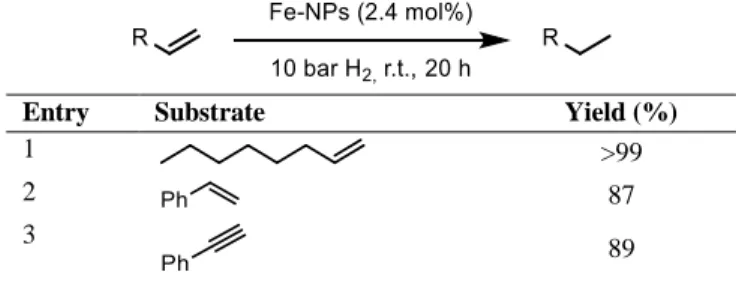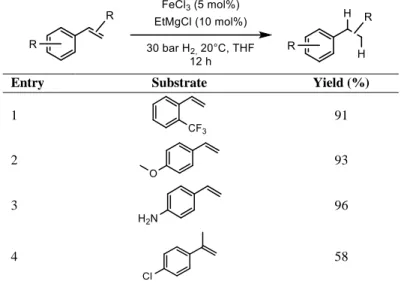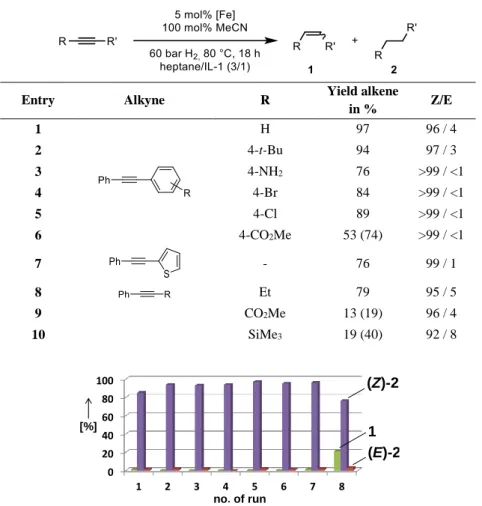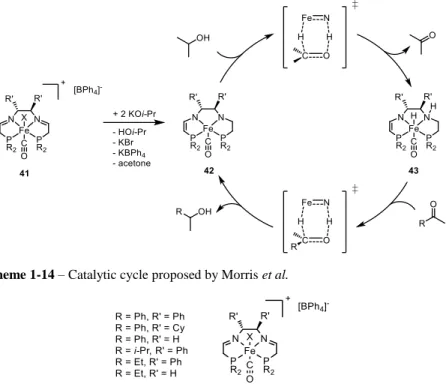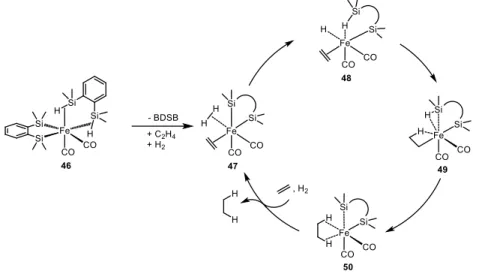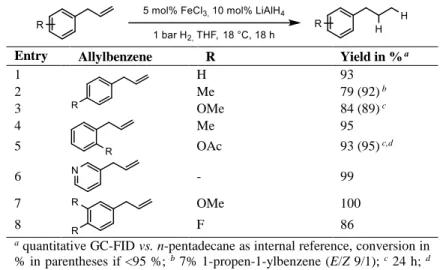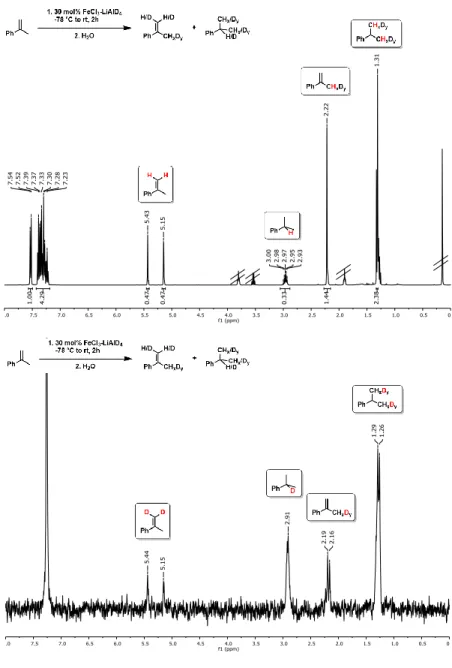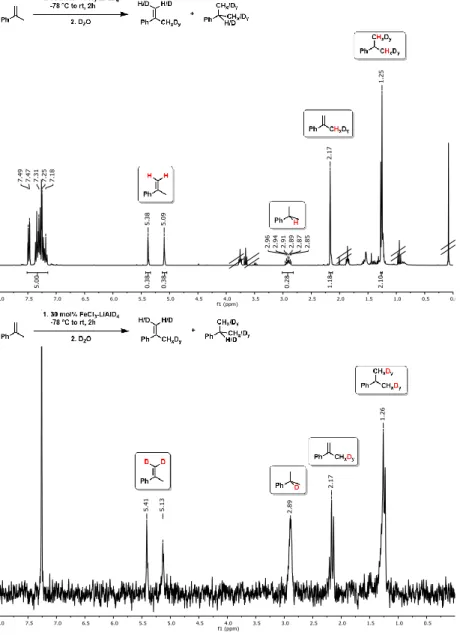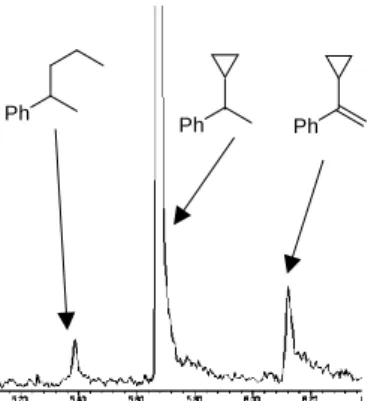Hydrogenation of Olefins”
Dissertation
zur Erlangung des Doktorgrades der Naturwissenschaften Dr. rer. nat.
an der Fakultät für Chemie und Pharmazie der Universität Regensburg
vorgelegt von Matteo Villa
aus Busto Arsizio (Italienische Republik)
Regensburg 2017
under the supervision of Prof. Dr. Axel Jacobi von Wangelin.
The thesis was submitted: April 10th, 2017 Date of the defence: May 11th, 2017
Board of examiners:
Prof. Dr. Achim Göpferich (chairman)
Prof. Dr. Axel Jacobi von Wangelin (1st referee) Prof. Dr. Olga García Mancheño (2nd referee) Prof. Dr. Frank-Michael Matysik (examiner)
Table of Contents
1 Introduction 1
1.1 Iron-catalyzed hydrogenation 1
1.1.1 Heterogeneous Iron Catalysts 3
1.1.2 Homogeneous Iron Catalysts 7
1.1.3 Homogeneous Iron Catalysts with Non-Innocent Ligands 11
1.2 References 21
2 Iron-catalyzed olefin hydrogenation at 1 bar H2 with a FeCl3-LiAlH4 catalyst 24
2.1 Introduction 25
2.2 Reaction conditions and substrate scope 26
2.3 Mechanistic studies 31
2.4 Conclusions 35
2.5 Experimental part 36
2.5.1 General 36
2.5.2 General hydrogenation procedures 37
2.5.4 Synthesis of starting material 38
2.5.5 Hydrogenation products 55
2.5.3 Mechanistic experimental details 71
2.5.6 [Li(thf)2{Fe(tmeda)}2(µ-AlH5)(µ-Al2H9] (4) 80
2.6 References 82
3 Alkene Hydrogenations by Soluble Iron Nanocluster Catalysts 85
3.1 Introduction 86
3.2 Results and Discussion 88
3.2 Conclusions 93
3.2 Experimental part 94
3.2.1 General 94
3.2.2 General procedures 96
3.2.3 General method for catalyst preparation 96
3.2.4 General method for in situ catalyst preparation with LiN(SiMe3)2 96 3.2.5 General method for in situ catalyst preparation with various amines 96
3.2.6 General method for catalytic hydrogenation 96
3.2.7 General method for kinetic examination in catalytic hydrogenation 97 3.2.8 Synthesis of catalysts, reagents, and starting materials 98 3.2.9 Synthesis and characterization of [FeN(SiMe3)2]4(toluene) 118 3.2.10 Synthesis of [Fe6{N(SiMe3)2}6H5] and [Fe7{N(SiMe3)2}7H6]: 122
3.3 References 126
4 Synthesis and Catalysis of Redox-active Bis(imino)acenaphthene (BIAN) Iron
Complexes 129
4.1 Introduction 130
4.2 Results and Discussion 132
4.2.1 Synthesis 132
4.2.2 Characterizations 134
4.2.3 Catalytic studies 140
4.3 Conclusions 141
4.3 Experimental part 142
4.3.1 General 142
4.3.2 Electrochemistry 143
4.3.3 X-Ray Diffraction 144
4.3.4 General procedure for the synthesis (Ar2BIAN)FeCl2 (2) 145 4.3.5 General procedure for the synthesis [Fe(Ar2BIAN)3][BF4]2 (4) 146 4.3.6 General procedure for the synthesis [Zn(Ar2BIAN)3][BF4]2 (5) 147 4.3.7 General procedure for catalytic hydrogenations of alkenes 147
4.3.8 Synthesis of starting materials 148
4.3.9 Hydrogenation products 149
4.4 References 178
5 Hydrogenations catalyzed by Redox-active Bis(imino)acenaphthene (BIAN) Iron
Complexes 183
5.1 Introduction 184
5.2 Results and Discussion 185
5.3 Mechanistic experiments 192
5.4 Conclusions 194
5.5 Experimental part 195
5.4.1 General 195
5.4.2 General procedure for catalytic hydrogenations 196
5.4.3 Synthesis (dipp2BIAN)FeCl2 196
5.4.4 Synthesis of starting material 197
5.4.5 Hydrogenation products 199
5.6 References 205
6 Synthesis of Reduced Bis(imino)acenaphthene (BIAN) Aluminium Complexes 207
6.1 Introduction 208
6.2 Results and Discussion 212
6.3 Conclusion 215
6.4 Experimental part 216
6.4.1 General 216
6.4.2 Synthesis of Aluminum-Complexes 217
6.5 References 220
7 Hydroaminations of Alkenes: A Radical, Revised, and Expanded Edition 221
7.1 References 226
8 Appendix 227
8.1 List of abbreviations 227
8.2 Summary 228
8.3 Zusammenfassung 232
8.4 Curriculum Vitae 236
8.5 Acknowledgements 238
8.6 Eidesstattliche Erklärung 239
1
1 Introduction
1.1 Iron-catalyzed hydrogenation
Catalysis represents a key technology for the industrial production of almost 80% of all chemical and pharmaceutical products.[1] Among the different processes, metal-catalyzed hydrogenations emerged as one of the most important transformations for both small as well as for the large scale productions[2], and as a matter of fact, the syntheses of many bulk and fine chemicals incorporate at least a hydrogenation step in the sequence. Taking a look at the pharmaceutical sphere, it is clear that in order to efficiently achieve such kind of transformation the catalyst needs to possess specific features like activity, chemoselectivity, and stereoselectivity. In the last couple of decades, a large number of homogeneous metal catalysts based on the noble metals, rhodium, iridium, palladium, platinum, and ruthenium, assisted by rational-designed and expensive ligands has been developed. These catalytic systems fulfill the previously mentioned properties and opened the pathway to the synthesis of fine chemicals inaccessible before. The relevance of these discoveries in the scientific field has been acknowledged with Nobel prizes at the beginning of this century.
Figure 1-1 – William S. Knowles and Ryoji Noyori awarded with the Nobel Prize in chemistry in 2001 “for their work on chirally catalyzed hydrogenation reactions”.
Despite the high activity and chemoselectivity showed by these catalysts, their major drawback consists in the low natural abundance of the metals they are based on, resulting in increased operational costs. The price of palladium for example almost doubled during the past 10 years.[3] Additionally, these metals are toxic, and their disposal is money and time-consuming. The sustainability and “green chemistry” principles, fully embraced nowadays by the scientific community expedite the development of new and more eco- friendly catalytic systems. One of the most promising candidates for the substitution of
2
these expensive and harmful metals is iron, being the 10th most abundant chemical element in the universe and exhibiting a clear safety profile. Interestingly, nitrogen fixation (Haber-Bosch) and carbon monoxide reduction (Fischer-Tropsch), two of the largest technical hydrogenations are catalyzed by heterogeneous iron species, but no competitive iron-catalyzed hydrogenations of fine chemical intermediates are employed yet. This field has acquired more and more attention in the last years and many Fe-based catalytic systems have been published so far.
3 1.1.1 Heterogeneous Iron Catalysts
In order to achieve robust iron-based catalytic systems, suitable for industrial applications, heterogeneous catalysts offer clear advantages, mainly the easy separation of the metal- free products' phase. Thanks to the recent availability of advanced synthetic and spectroscopic techniques, the synthesis and characterization of low valent iron nanoparticles have become easier.[4] Fe-NPs, as hybrid catalysts, combine the high activity and high dispersion of the homogeneous catalytic systems with the native heterogeneous properties.
Scheme 1-1 – Classical approaches for nanoparticles production.
Different approaches have been developed for the synthesis of nanoparticles, thermal decomposition of iron carbonyls (Fe(CO)5, Fe2(CO)9 and Fe3(CO)12)led to the formation of iron(0) particles. Different groups reported[5] the efficient synthesis of Fe-NPs according to this methodology, usually surfactants, such as oleylamine or ionic liquids, were added to slow down the aggregation of the newly formed particles.Mooreset al.
reported in 2013[6] a hydrogenation catalyst composed of iron(0) nanoparticles derived from decomposition of iron pentacarbonyl. These nanoparticles were supported on polystyrene beads thanks to polyethylene glycol linkers functionalized with amino groups, that served as stabilizers. Hydrogenation of primary and secondary alkenes, aldehydes and imines was achieved employing a flow set-up (Figure 1-2), this catalytic system also proved to be robust in the presence of water. Sonochemical treatment can be used as well to achieve iron carbonyls decomposition as reported by Stein et al. in 2011.[7] Under these conditions, without heating, they efficiently produced iron(0) nanoparticles supported on chemically-derived graphene, this supported catalyst proved to be active in the hydrogenation of alkenes.
4
Figure 1-2 – Substrate scope reported by Moores et al.; Bonds in blue indicate the site of π-bond hydrogenation; Reaction conditions: 0.05 M substrate in EtOH, 100 °C, 40 bar H2, 1 mL/min, 300 mg FeNP@PS-PEG-NH2 (residence time 53 seconds).
Reduction of iron oxides represents a feasible approach for the synthesis of iron nanoparticles, Kang et al. described[8] the thermal decomposition of iron(II) oleate to Fe3O4 and its subsequent reduction with H2 at high temperature (700°C) yielding α-Fe- NPs. The high temperature required in these processes is the major drawback of this approach. Chaudret in 2013[9] described the decomposition of Fe(hmds)2 to monodisperse nanoparticles under milder conditions (150°C, 3 bar H2). These NPs, with a diameter of 1.5 ± 0.2 nm, were then applied for the hydrogenation of primary and secondary alkenes and alkynes. Substrates without functional groups were almost quantitatively hydrogenated (Table 1-1), while ketones and aldehydes proved to be not suitable substrates for this catalytic system.
Table 1-1 – Hydrogenation of alkenes and alkynes with iron(0) nanoparticles reported by Chaudret et al.
Entry Substrate Yield (%)
1 >99
2 87
3 89
Wet reduction of iron salt proved in the last years to be the most applied approach for the synthesis of iron nanoparticles thanks to its easy operations and high versatility. A variety of reducing agents can be employed such as sodium borohydride, Super-Hydride, and Grignard reagents.[10] Thomas et al.[11] in 2013 described the formation of an active
5 hydrogenation catalyst obtained via reduction of commercial iron(II) triflate with sodium triethylborohydride. The reductant, used in large excess (4 equivalents), serves also as a hydrogen source, and the scope comprehended few examples of tri-substituted olefins. De Vries in 2009 reported[12] the reduction of cheap iron trichloride with three equivalents of EtMgCl resulting in Fe-NPs. These latter showed activity in the catalytic hydrogenation of alkenes and alkynes under mild reaction conditions. Few years later Welther et al.
described[13] the formation of iron nanoparticles applying a similar approach (FeCl3 as iron precursor and Grignard reagents as reductants). The particles were extensively studied, and then applied in alkenes hydrogenation. Notably, chlorides, ethers, esters, primary and tertiary amides are tolerated by the system (Table 1-2).
Table 1-2 - Functional group tolerance of iron-NPs described by Welther et al.
Entry Substrate Yield (%)
1 91
2 93
3 96
4 58
The implementation of ionic liquids led to a biphasic system in which the catalyst, dispersed in the IL phase, is stabilized, and can easily be separated by the products solubilized in the organic phase (heptane). Recycling of the catalyst by decantation is extremely effective, and its activity is conserved for more than 5 cycles (Figure 1-3).
Gieshoff et al.[14] expanded the application of this nanoperticles even further. Addition of acetonitrile effects the stereocontrol, coordinating to the particles surface it decreases the reactivity of the system, enabling the selective partial hydrogenation of alkynes to (Z)- alkenes (Table 1-3).
6
Table 1-3 - Partial hydrogenation of alkynes to (Z)-alkenes.
Entry Alkyne R Yield alkene
in % Z/E
1 H 97 96 / 4
2 4-t-Bu 94 97 / 3
3 4-NH2 76 >99 / <1
4 4-Br 84 >99 / <1
5 4-Cl 89 >99 / <1
6 4-CO2Me 53 (74) >99 / <1
7 - 76 99 / 1
8 Et 79 95 / 5
9 CO2Me 13 (19) 96 / 4
10 SiMe3 19 (40) 92 / 8
Figure 1-3 - Recycling of iron-nanoparticles catalyst.
no. of run [%]
0 20 40 60 80 100
1 2 3 4 5 6 7 8
1 (Z)-2
(E)-2
7 1.1.2 Homogeneous Iron Catalysts
Homogeneous catalyzed hydrogenation has been dominated by noble metal based catalysts, nevertheless the great effort invested by different research groups in the last years yielded some interesting results. Additionally, compared to their heterogeneous counterpart, easier mechanistic investigations on homogeneous catalytic systems lead the way to a rational tuning of the catalysts.
Highly reduced iron species represent valid candidates as hydrogenation catalysts, ferrate stabilized by π-systems such as naphthalene or anthracene were firstly conveniently synthesized by the group of Ellis[15] and Wolf[16] by simple reduction of iron halide with a mixture of alkali metals (K) and the desired arene (Scheme 1-2). The result of this reductions are homogeneous iron complexes (3) with the metal atom in a negative formal oxidation state (-1). The easy substitution of the coordinated π-ligand with different arenes and dienes represent a good methodology for the synthesis of a collection of ferrates. The Jacobi von Wangelin group in collaboration with Wolf and co-workers tested these complexes in the hydrogenation of olefins.[16-17] Simple alkenes were efficiently hydrogenated under mild conditions, unfortunately, the high reactivity of these complexes is translated in low tolerance for functional groups (Table 1-4).
Scheme 1-2 - Synthesis of ferrate according to Ellis et al.
Table 1-4 – Hydrogenation of styrenes catalyzed by complex 3.
Entry R Yield (%)
1 H 89
2 4-F 100
3 4-NH2 0
4 4-COOMe 2
5 2-Cl 0
8
Phosphines represent one of the most investigated class of ligands employed in coordination chemistry. The application of transition metals complexes bearing organophosphorus moieties in the catalytic hydrogenation of unsaturated bonds allowed the achievement of astonishing results. Thanks to the profuse efforts carried on by different research groups in the last couple of decades, the library of well-defined iron- phosphine complexes increased exponentially. Among these, different ones showed interesting reactivity towards hydrogenation.
Multidentate phosphines are usually employed for these applications. Bianchini[18] and Peters[19] proved the activity of iron fragments coordinated to such ligands respectively for the partial hydrogenation of alkynes (4) and for the full hydrogenation of alkynes and alkenes (5, 6). The key active intermediate for both of these catalytic systems is an iron- hydride species formed in situ and detected by NMR spectroscopy. This species after each turnover is regenerated by dihydrogen, this reactivation step was proposed by the authors after detection of LFeH(η2-H2) (7) and LFe(H3) (8) species in the reaction mixture (Scheme 1-3).
Figure 1-4 – Iron-phospine complexes described by Bianchini et al.(4) and Peters et al. (5, 6).
Scheme 1-3 – Equilibrium between Fe-H species detected by Peters et al.
Similar tetradentate phosphines (9) have been employed in 2012 by Beller et al. for the partial hydrogenation of phenylacetylenes to styrenes.[20] The catalyst was formed in situ, mixing Fe(H2O)6(BF4)2 and the ligand. Formic acid was employed as hydrogen source and an iron fluoride intermediate (10) was proposed by the authors as active catalytic species (Scheme 1-4).
9 Scheme 1-4 – Catalytic cycle proposed by Beller et al.
Table 1-5 – Substrate scope reported by Beller et al.
Entry Substrate Catalyst (mol%) Conv. (%) Yield (%)
1 0.75 >99 >99
2 1 >99 >99
3 0.75 >99 >99
4 1.25 >99 98
5 0.75 >99 >99
10
6 1 >99 >99
7 2.5 >99 >99
The authors presented a broad scope for this catalytic system, the presence of reducible functional groups did not affect the chemoselectivity of the process. The same group applied this approach for the reduction of different substrates such as carbon dioxide[21]
and for the chemoselective carbonyl reduction of α,β-unsaturated aldehydes.[22]
11 1.1.3 Homogeneous Iron Catalysts with Non-Innocent Ligands
As mentioned in the previous chapter the majority of homogeneous catalysts so far investigated and applied in hydrogenation are based on noble metals, while iron has been deeply investigated only in the last couple of decades. A reason for this delay could be found in the redox properties of these elements. Noble metals like palladium, platinum, rhodium, iridium and ruthenium easily undergo two-electron oxidative and reductive processes, thus are greatly favored for the development of the classical transition organometallic chemistry. Iron, on the other hand, can also engage even-numbered redox events but single electron transfer (SET) is always a competitive pathway and in many cases even preferred. This innate electronic structure represented a great limitation for the development of homogeneous iron-catalyzed processes. To overcome this problem different approaches are feasible but one approach has been shown to be very successful, namely the adoption of an organic molecule structure coordinated to the metal, which is able to cooperate with it during the redox processes: a non-innocent ligand. The importance of this ligands can be evaluated based on the number of reviews concerning this topic published in the last couple of years [23].
Figure 1-5 – Classical non-innocent ligand scaffolds.
These ligands can be generically divided into two major classes based on their role in the catalytic pathway. The first one is composed by those ligands with a spectator role, they do not interact directly with the substrate, the catalytic activity is primarily metal-centered, however, they can act as electron reservoirs. The second class comprehends ligands which actively participate in the catalytic process forming and breaking bonds with the substrates, assuming an actor role.
Scheme 1-5 - Pricipal operation modes of non-innocent ligands.
Among the first class of non-innocent ligands, one of the most noteworthy structural motifs is the bis(imino)pyridine (PDI) one. These (NNN)-pincer ligands and their non-
12
innocent behavior are known from many years, with their first synthesis being reported more than 40 years ago[24], as a simple condensation between 2,6-pyridinecarboxaldehyde or 2,6-diacetylpyridine with the corresponding aniline (Scheme 1-6).
Scheme 1-6 - Classical synthesis of PDI ligands.
Only very recently they assumed a primary role in homogeneous iron-catalyzed transformations, a broad range of reactions such as polymerizations, hydrosilylation, and hydroboration were efficiently promoted by iron-PDI complexes.[25] Regarding hydrogenations, seminal work was done by Chirik et al.. In a first report in 2004[26], they reported the initial promising results, hydrogenation of mono- and di-substituted olefins was perfectly achieved within minutes. The active catalyst is formed by reduction of the pre-catalyst (PDI)FeBr2 (15) with two equivalents of sodium or sodium triethylborohydride, the reduce complex is then trapped with nitrogen or carbon monoxide yielding square pyramidal active catalysts 16 and 17 (Scheme 1-7).
Scheme 1-7 - Synthesis of active (PDI)Fe species according to Chirik et al.
After a couple of years detailed structural, spectroscopic and computation studies were published by the same author[27] and proved that the non-innocent behaviour of the ligand
13 is the key feature of this catalytic system. This example is the perfect case study for the explanation of the behaviour of redox active spectator ligans. Reduction of the initial iron precursor 15 occurs at the ligand and not at metal center (Scheme 1-8). The active catalyst is not an iron(0) species 16, but is better described as an iron(II) species coordinated with a radical dianionic ligand, 19.
Scheme 1-8 – Reduction of PDI-iron complexes.
The catalytic cycle proposed by Chirik for these catalysts is described in Scheme 1-9:
initial decoordination of nitrogen molecules and coordination of the substrate leads to the formation of 21, in the next step oxidative addition plays a crucial role and 21 is formally 2 electrons oxidized maintaining the iron center in formal oxidation state (+2)(22).
Insertion of the substrate in the metal-hydrogen bond results in the formation of the iron- alkyl complex 23, final reductive elimination forms the product and reduces the ligand back to the initial stage (20).
Scheme 1-9 - Catalytic cycle proposed by Chirik et al.
14
In 2005 the group Danopoulos et al.[28] described the synthesis of iron pincer complexes in which the imino functionalities of the PDI ligand were substituted by N-heterocyclic carbenes (25). Inspired by this work and by the observation that addition of electron donating groups on the pyridine ring has an influence on the electronic properties of the metal[29], Chirik et al. investigated these (CNC)Fe(N2)2 complexes for the hydrogenation of alkenes with outstanding results.[30] Applying only 4 bars of hydrogens tri-substituted unfunctionalized olefins such as alpha-methyl stilbene, 2-methyl-2-butene, and 1- methylcyclohexene were quantitively hydrogenated, even the tetra-substituted 2,3- dimethy-1H-lindene was converted up to 60 % (Table 1-6, entry 5). Functionalized substrates, for example, acrylates, represented the limit of this catalytic system, with poor conversions with (CNC)Fe(N2)2 as the catalyst (Table 1-6, entry 1).
Figure 1-6 - Iron pincer complexes investigated by Chirik et al.
Table 1-6 - Hydrogenation results obtained with complexes 24 and 25.
Entry Substrate Conversion (%)
with 24
Conversion (%) with 25
1 >95 35
2 76 >95
3 15 >95
4 3 >95
5 3 68(48 h)
15 Not only PDI ligands showed to be efficient non-innocent ligands for iron-catalyzed hydrogenation reactions. Other pincer ligands afforded very interesting and reactive iron- based catalysts. One of the first publications describing a (PNP)Fe complex was from Milstein’s laboratories.[31] The core structure (26) was also in this case composed of a central pyridine ring, with two additional phosphine chelating groups bound to the aromatic ring in 2,2’ position, using a methylene spacer to ensure the best coordination geometry. These complexes were first applied in the hydrogenation of carbon dioxide[31a]
and ketones[31b] with very good results, the catalyst loading was lowered to 0.05 mol%, ensuring turnover numbers up to 2000, remarkable results in the field of iron catalysis (Table 1-7).
Scheme 1-10 - Synthesis of (PNP)-Fe complexes according to Milstein et al.
Table 1-7 - Hydrogenation of substituted ketones with 27.
Entry R Yield (%)
1 H 94
2 Cl 86
3 Br 78
4 Me 72
The catalytic cycle proposed by the authors is showed in Scheme 1-11, the non-innocent ligand participate actively creating covalent bonds with the reagent, dihydrogen. The initial deprotonation of 27 results in the dearomatization of the pyridine ring, and thanks to the newly formed anionic nitrogen ligand the bromide can decoordinate from the metal center, with the oxidation state of iron in complex 28 still being (+2). The vacant site is occupied by the substrate, subsequent migration of the hydride leads to complex 30.
Rearomatization of the pyridine ring occurs in 31 after the activation of a dihydrogen molecule. Elimination of the product regenerates the initial catalyst 28.
16
Scheme 1-11 - Catalytic cycle for hydrogenation of ketone proposed by Milstein et al.
Following the same idea, different research groups developed similar ligands and complexes. In the time period of just a few months, Beller[32], Guan[33] and Jones[34]
independently reported the application of Fe-bis(phosphino)amine complexes (Scheme 1- 12) as competent catalyst for the hydrogenation(33)/dehydrogenation(35) of different classes of molecules, such as esters, alcohols, and N-heterocycles.
Scheme 1-12 - Synthesis of Fe-bis(phospino)amine complexes according to Guan et al.
17 From their reports it appears clear, that also in this case the ligand participates actively in the catalysis abstracting a proton from the substrate. As a proof of this concept, dehydrogenation attempts of tetraline with 35 failed while the more acidic tetrahydroquinoline showed good conversion.
In a follow-up paper[35], the same authors increased the scope of this catalyst to the hydrogenation of primary and secondary olefins, but even more interestingly Xu et al.
proved, thanks to experimental and theoretical evidences, the critical importance of the polarity of the substrate’s C=C double bond for an efficient hydrogenation. Translating this information to the operative catalytic cycle the authors proposed a metal-ligand cooperative pathway via stepwise hydride transfer from the metal to the substrate (transition state 37), followed by a proton transfer from the ligand (transition state 39) (Scheme 1-13).
Scheme 1-13 - Mechanism proposed by Jones et al.
Slight modifications of this catalyst showed activity for other substrates families, Lange et al. in 2016[36], exchanged the aliphatic groups on the phosphine moieties, obtaining a competent catalyst for the hydrogenation of nitriles to the corresponding primary amines.
Despite the high hydrogen pressure needed, good to excellent yield were obtained, and a broad range of functional groups was tolerated.
The Langer group last year[37] thoroughly explored the reactivity of Fe- bis(phosphino)complexes, and applied them to the hydrogenation of amides, yielding alcohols and amines. Investigating structural alterations on the PNP ligand they performed
18
a fine tuning of the scaffold, finally identifying in the one bearing less bulky ethyl-groups the best compromise between stability and activity of the catalyst.
Tetradentate PNNP ligand motifs have been thoroughly investigated by Morris et al. in the last decade[38]. Different ligand structures were described by the group (Figure 1-7), chiral backbones were applied, leading this catalytic system to be one of the first iron- based catalyst reported for asymmetric transfer hydrogenation of ketones. Turnover frequencies of over 25000 h-1 and excellent enantioselectivities were achieved.
Detailed kinetic[39] and DFT[40] studies proved the outer-sphere mechanism of this tranformation (Scheme 1-14). A base, mandatory for the catalytic activity, initially deprotonate the neutral ligand in 41, the resulting active complex 42, then, dehydrogenates the sacrificial hydrogen source, usually isopropanol. The newly formed iron-hydride species 43 can subsequently reduce the substrate closing the catalytic cycle. As in the previously reported examples, this ligand has an actor role in this reaction, abstracting/donating a proton and keeping the metal center in +2 oxidation state.
Scheme 1-14 – Catalytic cycle proposed by Morris et al.
Figure 1-7 – Few examples of PNNP-iron complexes described by Morris et al.
19 Not only pincer ligands show non-innocent behavior, in 2013 Nagashima et al.[41] reported an iron complex obtained irradiating with an high pressure mercury lamp of a mixture of one equivalent of (4-C6H8)Fe(CO)3 (44) with two equivalents of bis(dimethylsilyl)benzene (BDSB) (45). The resulting (46) is a distorted octahedral iron complex with two cis-CO ligands (Scheme 1-15). The exceptional hydrogenation activity of this complex is shown in Table 1-8, tri- and tetra-substituted olefins, extremely challenging substrates, were hydrogenated after six hours with only 1 bar of hydrogen.
Scheme 1-15 - Synthesis of 46 according to Nagashima et al.
Table 1-8 - Hydrogenation of di-, tri- and tetra-substituted alkenes with 46.
Entry R Yield (%)
1 99
2 99
3 59
4 20
Last year[42] the same group reported interesting theoretical investigations about this complex that clarified its hydrogenation mechanism. The proposed cycle is shown in Scheme 1-16. Despite the different structure, this complex also owes its activity to the silyl ligand non-innocent behavior. After the initial decoordination of a bis(dimethylsilyl)benzene molecule, the resulting vacant sites are occupied by the substrate (simple ethene was employed for this study) and one molecule of dihydrogen (47). H2 is then cooperatively cleaved by a silyl group of BDSB in conjunction with the metal center yielding 48, the next step is an insertion of the substrate C=C double bond in the Fe-H bond, and finally hydrogen migration from the iron center to ethylene ligand
20
leads to the formation of the product and the regeneration of the initial iron complex, closing the catalytic cycle.
Scheme 1-16 - Catalytic cycle proposed by Nagashima et al.
Cyclopentadienones also belong to the non-innocent ligand family. Iron complexes containing this ligand motif, Knölker complexes (Figure 1-8), were firstly described by the homonym author almost two decades ago[43] and subsequently have been successfully employed as catalysts for hydrogenation reactions.[44] These systems have been deeply investigated, determining that a heterolytic cleavage of dihydrogen assisted by the cyclopentadienone ligand is the key step for the high activity of these complexes.
Figure 1-8 – First iron hydroxycyclopentadienyl complex reported by Knölker et al.
21 1.2 References
[1] S. Enthaler, K. Junge, M. Beller, Angew. Chem. Int. Ed. 2008, 47, 3317-3321.
[2] The Handbook of Homogeneous Hydrogenation, Wiley-VCH, Weinheim, 2007.
[3] http://www.monex.com/prods/palladium_chart.html.
[4] D. Astruc, Nanoparticles & Catalysis, Wiley-VCH, Weinheim, 2008.
[5] a) H. Kura, M. Takahashi, T. Ogawa, J. Phys. Chem. C 2010, 114, 5835-5838; b) J.
Krämer, E. Redel, R. Thomann, C. Janiak, Organometallics 2008, 27, 1976-1978.
[6] R. Hudson, G. Hamasaka, T. Osako, Y. M. A. Yamada, C.-J. Li, Y. Uozumi, A.
Moores, Green Chem. 2013, 15, 2141-2148.
[7] M. Stein, J. Wieland, P. Steurer, F. Tölle, R. Mülhaupt, B. Breit, Adv. Synth. Catal.
2011, 353, 523-527.
[8] Y. C. Han, H. G. Cha, C. W. Kim, Y. H. Kim, Y. S. Kang, J. Phys. Chem. C 2007, 111, 6275-6280.
[9] V. Kelsen, B. Wendt, S. Werkmeister, K. Junge, M. Beller, B. Chaudret, Chem.
Commun 2013, 49, 3416-3418.
[10] a) C. Rangheard, C. de Julian Fernandez, P.-H. Phua, J. Hoorn, L. Lefort, J. G. de Vries, Dalton Tran. 2010, 39, 8464-8471; b) D. J. Frank, L. Guiet, A. Kaeslin, E.
Murphy, S. P. Thomas, RSC Adv. 2013, 3, 25698-25701; c) A. J. MacNair, M.-M.
Tran, J. E. Nelson, G. U. Sloan, A. Ironmonger, S. P. Thomas, Org. Biomol. Chem.
2014, 12, 5082-5088.
[11] T. S. Carter, L. Guiet, D. J. Frank, J. West, S. P. Thomas, Adv. Synth. Catal. 2013, 355, 880-884.
[12] P.-H. Phua, L. Lefort, J. A. F. Boogers, M. Tristany, J. G. de Vries, Chem. Commun.
2009, 3747-3749.
[13] A. Welther, M. Bauer, M. Mayer, A. Jacobi von Wangelin, ChemCatChem 2012, 4, 1088-1093.
[14] T. N. Gieshoff, A. Welther, M. T. Kessler, M. H. G. Prechtl, A. Jacobi von Wangelin, Chem. Commun 2014, 50, 2261-2264.
[15] W. W. Brennessel, R. E. Jilek, J. E. Ellis, Angew. Chem. Int. Ed. 2007, 46, 6132- 6136.
[16] D. Gaertner, A. Welther, B. R. Rad, R. Wolf, A. Jacobi Von Wangelin, Angew.
Chem. Int. Ed. 2014, 53, 3722-3726.
[17] P. Buschelberger, D. Gartner, E. Reyes-Rodriguez, F. Kreyenschmidt, K.
Koszinowski, A. Jacobi von Wangelin, R. Wolf, Chem. Eur. J. 2016.
[18] a) C. Bianchini, M. Peruzzini, F. Zanobini, J. Organomet. Chem. 1988, 354, C19- C22; b) C. Bianchini, A. Meli, M. Peruzzini, F. Vizza, F. Zanobini, P. Frediani, Organometallics 1989, 8, 2080-2082; c) C. Bianchini, A. Meli, M. Peruzzini, P.
Frediani, C. Bohanna, M. A. Esteruelas, L. A. Oro, Organometallics 1992, 11, 138- 145.
[19] a) E. J. Daida, J. C. Peters, Inorg. Chem. 2004, 43, 7474-7485; b) H. Fong, M.-E.
Moret, Y. Lee, J. C. Peters, Organometallics 2013, 32, 3053-3062.
[20] G. Wienhofer, F. A. Westerhaus, R. V. Jagadeesh, K. Junge, H. Junge, M. Beller, Chem. Commun. 2012, 48, 4827-4829.
[21] C. Federsel, A. Boddien, R. Jackstell, R. Jennerjahn, P. J. Dyson, R. Scopelliti, G.
Laurenczy, M. Beller, Angew. Chem. Int. Ed. 2010, 49, 9777-9780.
22
[22] G. Wienhöfer, F. A. Westerhaus, K. Junge, M. Beller, J. Organomet. Chem. 2013, 744, 156-159.
[23] a) L. A. Berben, B. de Bruin, A. F. Heyduk, Chem. Commun. 2015, 51, 1553-1554;
b) S. Blanchard, E. Derat, M. Desage-El Murr, L. Fensterbank, M. Malacria, V.
Mouries-Mansuy, Eur. J. Inorg. Chem. 2012, 2012, 376-389; c) A. Fuerstner, ACS Cent. Sci. 2016, 2, 778-789; d) W. Kaim, Eur. J. Inorg. Chem. 2012, 2012, 343- 348; e) V. Lyaskovskyy, B. De Bruin, ACS Catal. 2012, 2, 270-279; f) P. J. Chirik, K. Wieghardt, Science 2010, 327, 794.
[24] E. C. Alyea, P. H. Merrell, Synth. React. Inorg. Met.-Org. Chem. 1974, 4, 535-544.
[25] a) S. K. Russell, E. Lobkovsky, P. J. Chirik, J. Am. Chem. Soc. 2011, 133, 8858- 8861; b) A. M. Tondreau, C. C. H. Atienza, J. M. Darmon, C. Milsmann, H. M.
Hoyt, K. J. Weller, S. A. Nye, K. M. Lewis, J. Boyer, J. G. P. Delis, E. Lobkovsky, P. J. Chirik, Organometallics 2012, 31, 4886-4893; c) J. H. Docherty, J. Peng, A.
P. Dominey, S. P. Thomas, Nat Chem 2017, advance online publication; d) A. M.
Tondreau, E. Lobkovsky, P. J. Chirik, Org. Lett. 2008, 10, 2789-2792; e) K. T.
Sylvester, P. J. Chirik, J. Am. Chem. Soc. 2009, 131, 8772-8774; f) B. L. Small, M.
Brookhart, J. Am. Chem. Soc. 1998, 120, 7143-7144; g) B. L. Small, M. Brookhart, A. M. A. Bennett, J. Am. Chem. Soc. 1998, 120, 4049-4050; h) G. J. P. Britovsek, M. Bruce, V. C. Gibson, B. S. Kimberley, P. J. Maddox, S. Mastroianni, S. J.
McTavish, C. Redshaw, G. A. Solan, S. Stroemberg, A. J. P. White, D. J. Williams, J. Am. Chem. Soc. 1999, 121, 8728-8740; i) G. J. P. Britovsek, V. C. Gibson, B. S.
Kimberley, P. J. Maddox, S. J. McTavish, G. A. Solan, A. J. P. White, D. J.
Williams, Chem. Commun. 1998, 849-850; j) M. W. Bouwkamp, E. Lobkovsky, P.
J. Chirik, J. Am. Chem. Soc. 2005, 127, 9660-9661.
[26] S. C. Bart, E. Lobkovsky, P. J. Chirik, J. Am. Chem. Soc. 2004, 126, 13794-13807.
[27] S. C. Bart, K. Chlopek, E. Bill, M. W. Bouwkamp, E. Lobkovsky, F. Neese, K.
Wieghardt, P. J. Chirik, J. Am. Chem. Soc. 2006, 128, 13901-13912.
[28] A. A. Danopoulos, J. A. Wright, W. B. Motherwell, Chem. Commun. 2005, 784- 786.
[29] J. M. Darmon, Z. R. Turner, E. Lobkovsky, P. J. Chirik, Organometallics 2012, 31, 2275-2285.
[30] R. P. Yu, J. M. Darmon, J. M. Hoyt, G. W. Margulieux, Z. R. Turner, P. J. Chirik, ACS Catal. 2012, 2, 1760-1764.
[31] a) R. Langer, Y. Diskin-Posner, G. Leitus, L. J. Shimon, Y. Ben-David, D. Milstein, Angew. Chem. Int. Ed. 2011, 50, 9948-9952; b) R. Langer, G. Leitus, Y. Ben-David, D. Milstein, Angew. Chem. Int. Ed. 2011, 50, 2120-2124.
[32] E. Alberico, P. Sponholz, C. Cordes, M. Nielsen, H. J. Drexler, W. Baumann, H.
Junge, M. Beller, Angew. Chem. Int. Ed. 2013, 52, 14162-14166.
[33] S. Chakraborty, H. Dai, P. Bhattacharya, N. T. Fairweather, M. S. Gibson, J. A.
Krause, H. Guan, J. Am. Chem. Soc. 2014, 136, 7869-7872.
[34] S. Chakraborty, W. W. Brennessel, W. D. Jones, J. Am. Chem. Soc. 2014, 136, 8564-8567.
[35] R. Xu, S. Chakraborty, S. M. Bellows, H. Yuan, T. R. Cundari, W. D. Jones, ACS Catal. 2016, 6, 2127-2135.
[36] S. Lange, S. Elangovan, C. Cordes, A. Spannenberg, H. Jiao, H. Junge, S.
Bachmann, M. Scalone, C. Topf, K. Junge, M. Beller, Catal. Sci. Technol. 2016, 6, 4768-4772.
23 [37] F. Schneck, M. Assmann, M. Balmer, K. Harms, R. Langer, Organometallics 2016,
35, 1931-1943.
[38] a) P. O. Lagaditis, A. J. Lough, R. H. Morris, Inorg. Chem. 2010, 49, 10057-10066;
b) N. Meyer, A. J. Lough, R. H. Morris, Chem. Eur. J. 2009, 15, 5605-5610; c) A.
Mikhailine, A. J. Lough, R. H. Morris, J. Am Chem. Soc. 2009, 131, 1394-1395; d) A. A. Mikhailine, R. H. Morris, Inorg. Chem. 2010, 49, 11039-11044; e) R. H.
Morris, Chem. Soc. Rev. 2009, 38, 2282-2291; f) P. E. Sues, A. J. Lough, R. H.
Morris, Organometallics 2011, 30, 4418-4431; g) C. Sui-Seng, F. Freutel, A. J.
Lough, R. H. Morris, Angew. Chem. Int. Ed. 2008, 47, 940-943; h) C. Sui-Seng, F.
N. Haque, A. Hadzovic, A.-M. Pütz, V. Reuss, N. Meyer, A. J. Lough, M. Zimmer- De Iuliis, R. H. Morris, Inorg. Chem. 2009, 48, 735-743; i) W. Zuo, A. J. Lough, Y.
F. Li, R. H. Morris, Science 2013, 342, 1080.
[39] A. A. Mikhailine, M. I. Maishan, A. J. Lough, R. H. Morris, J. Am. Chem. Soc.
2012, 134, 12266-12280.
[40] D. E. Prokopchuk, R. H. Morris, Organometallics 2012, 31, 7375-7385.
[41] Y. Sunada, H. Tsutsumi, K. Shigeta, R. Yoshida, T. Hashimoto, H. Nagashima, Dalton Trans. 2013, 42, 16687-16692.
[42] A. Tahara, H. Tanaka, Y. Sunada, Y. Shiota, K. Yoshizawa, H. Nagashima, J Org.
Chem. 2016, 81, 10900-10911.
[43] a) H.-J. Knölker, E. Baum, H. Goesmann, R. Klauss, Angew. Chem. Int. Ed. 1999, 38, 2064-2066; b) H.-J. Knölker, E. Baum, J. Heber, Tetrahedron Lett. 1995, 36, 7647-7650; c) H.-J. Knölker, J. Heber, Synlett 1993, 1993, 924-926; dH.-J. Knölker, J. Heber, C. H. Mahler, Synlett 1992, 1992, 1002-1004.
[44] a) A. Quintard, J. Rodriguez, Angew. Chem. Int. Ed. 2014, 53, 4044-4055; b) A.
Berkessel, S. Reichau, A. von der Hoeh, N. Leconte, J.-M. Neudorfl, Organometallics 2011, 30, 3880-3887; c) A. von der Hoeh, A. Berkessel, ChemCatChem 2011, 3, 861-867; d) C. P. Casey, H. Guan, J. Am. Chem. Soc. 2007, 129, 5816-5817; e) A. Pagnoux-Ozherelyeva, N. Pannetier, M. D. Mbaye, S.
Gaillard, J.-L. Renaud, Angew. Chem. Int. Ed. 2012, 51, 4976-4980; f) S. Fleischer, S. Zhou, K. Junge, M. Beller, Angew. Chem. Int. Ed. 2013, 52, 5120-5124; g) C. P.
Casey, H. Guan, J. Am. Chem. Soc. 2009, 131, 2499-2507.
24
2 Iron-catalyzed olefin hydrogenation at 1 bar H
2with a FeCl
3- LiAlH
4catalyst
i,iiThe scope and mechanism of a practical protocol for the iron-catalyzed hydrogenation of alkenes and alkynes at 1 bar H2 pressure were studied. The catalyst is formed from cheap chemicals (5 mol% FeCl3-LiAlH4, THF). A homogeneous mechanism operates at early stages of the reaction while active nanoparticles form upon ageing of the catalyst solution.
iReproduced from T. N. Gieshoff, M. Villa, A. Welther, M. Plois, U. Chakraborty, R.
Wolf, A. Jacobi von Wangelin, Green Chem 2015, 17, 1408–1413 with permission from the Royal Society of Chemistry. Schemes, tables and text may differ from published version.
iiAuthors contribution: Initial experiments were performed by A. Welther (Table 2-1, Table 2-2, Table 2-3 entries 1, 2, 3, 6, 10, 11), see A. Welther, Dissertation, University Regensburg, 2013. Complex 4 (Scheme 2-3) was initially synthesized and analyzed by M.
Plois and resynthesized by U. Chakraborty, see M. Plois, Dissertation, University Regensburg, 2012. T. Gieshoff contributed equally in Table 2-3 and Table 2-4.
25 2.1 Introduction
Catalytic hydrogenations of olefins constitute one of the strongholds of transition metal catalysis within organic synthesis and technical processes.[1] The majority of these methods involve noble metal catalysts based on Pd, Pt, Rh, Ir or toxic metals such as Ni or Co. Iron-catalyzed hydrogenations of olefins have only recently attracted great interest due to their expedient economic and environmental qualities.[2] Homogeneous iron catalysts were mostly reported with phosphine and pyridyl-2,6-diimine ligands, sometimes requiring high pressures of H2.[3,4] Nanoparticle Fe catalysts could be prepared by reduction of iron salts with Grignard reagents in the absence of a suitable ligand or by decomposition of iron carbonyls.[5] Fe-catalyzed reductions of olefins were recently reported with cheap ferrous salt pre-catalysts FeX2 in the presence of an excess of lithium N,N-dimethylaminoborohydride (10 equiv.) or sodium triethylborohydride (4 equiv.) and required a high catalyst loading or the addition of tetra-dentate ligands.[6] Reductions of alkenes and alkynes with LiAlH4 in the presence of various transition metal halides (NiCl2, TiCl2, CoCl2, FeCl3) were already reported in the 1960s and postulated to involve metal hydride species that engage in formal hydrometalations of the olefin.[7] Here, we wish to present a synthetic and mechanistic study on a hydrogenation protocol using catalytic amounts of a cheap Fe salt and catalytic amounts of lithium aluminiumhydride (LiAlH4) as catalyst activator under an atmosphere of 1 bar H2 as stoichiometric hydrogen source (Scheme 2-1).[7e]
Scheme 2-1 - Iron-catalyzed reductions of olefins: Hydride vs. hydrogen methods.
This method allows the use of standard (ambient pressure) equipment. H2 is an abundant raw material; LiAlH4 is an easy-to-handle reductant with numerous applications.[8]
26
2.2 Reaction conditions and substrate scope
Initial experiments with the model substrate allylbenzene (1) aimed at the identification of a suitable catalytic reductant which assists the formation of a low-valent iron catalyst (with dark brown color) from the commercial pre-catalyst FeCl3 (Table 2-1).[9] LiAlH4
displayed excellent selectivity which exceeded that of earlier protocols with Grignard reagents.[5] Isomerization of the terminal double bond into conjugation – which occurred in the related EtMgCl-mediated protocols (entries 2, 4) – was effectively suppressed.[10]
NaBH4 was far less active even at elevated temperature and pressure (entries 6, 7).
Interestingly, low ratios of LiAlH4/FeCl3 (1/1 to 2/1) fared optimal in the hydrogenation of 1 at 1 bar H2. When employing a larger excess of LiAlH4 (>2/1), the catalytic activity collapsed.[7e] This stoichiometry differs from literature reports where large excess amounts of hydride reagents effected clean hydrogenations of olefins.[6,7a-c] At 60°C, the FeCl3/LiAlH4 catalyst decomposed upon decolorization.
Table 2-1 - Selected optimization experiments.
Entry Reductant (mol%)
Deviation from
conditions a 2 in %c 3 in
%c
1 - - <1 2
2 EtMgCl (30) - 42 56
3 EtMgCl (30) - b 16 <1
4 EtMgCl (30) 1 bar H2, 20 h 60 36
5 Et2Zn (20) 30 bar H2, 80 °C, 12
h 4 1
6 NaBH4 (100) 50 bar H2, 24 h 8 <1 7 NaBH4 (100)
MeOH/THF (1:1), 50 bar H2, 50 °C, 20 h
45 38
27
8 LiAlH4 (10) - 97 3
9 LiAlH4 (10) 1 bar H2, 20 h 98 1 10 LiAlH4 (30) as entry 9, open to
air d 95 3
11 LiAlH4 (10) FeCl2 96 1
12 LiAlH4 (10) Fe(acac)3 20 15
a Conditions: 5 mol% FeCl3 in THF (0.5 mL) under argon, addition of reductant at r.t., after 10 min addition of 1, after 1 min exchange of Ar with 4 bar H2; b prior storage of [FeCl3/red.] catalyst mixture in THF under argon for 3 d at r.t; c quantitative GC-FID vs. n-pentadecane as internal reference; d during catalyst preparation.
The catalyst system comprises of cheap and easy-to-handle reagents (FeCl3 or FeCl2, LiAlH4, THF); the reaction operates under ambient conditions (1 bar H2, 20°C), which make the general protocol practical for every-day use in standard synthesis laboratories.
The optimized conditions were applied to functionalized allylbenzenes and styrenes (Table 2-2 and Table 2-3).[9]
Allylbenzenes underwent only minimal olefin isomerization.[10] Styrenes exhibited low propensity to undergo polymerization (entry 13, Table 2-3). The general protocol is compatible with several functional groups including F, Cl, Br, allyl and benzyl ethers, esters, carboxamides, pyridines and anilines. Clean hydrogenation was achieved with bulky, ortho-substituted, and electron-rich styrenes. For comparison, the FeCl3/EtMgCl- derived catalyst effected undesired dehalogenation (Cl, Br)[11] and allylether cleavage[12], and showed no activity in the presence of carboxylates or cinnamates. Catalyst decomposition was effected by nitro groups, iodides, nitriles, ketones, and acidic protons (e.g. alkanols, pKa~17), presumably by oxidation to catalytically inactive Fe(II) species (decolorization). Tri-substituted styrenes gave low conversions. In general, bulky and functionalized substrates were more reactive at elevated pressures (10 bar H2).[13]
28
Table 2-2 - Hydrogenation of allylbenzenes at 1 bar H2.
Entry Allylbenzene R Yield in % a
1 H 93
2 Me 79 (92) b
3 OMe 84 (89) c
4 Me 95
5 OAc 93 (95) c,d
6 - 99
7 OMe 100
8 F 86
a quantitative GC-FID vs. n-pentadecane as internal reference, conversion in
% in parentheses if <95 %; b 7% 1-propen-1-ylbenzene (E/Z 9/1); c 24 h; d quantitative NMR (vs. CH2Br2)
Table 2-3 - Hydrogenation of styrene derivatives.
Entry Styrene R Yield in % a
1 H 100
2 Me 98
3 OMe 98
4 Cl 93 b
5 Br 94 b
6 F 83 (91)
7 OBn 100 d
8 NH2 97 c
9 CO2Me 97
29
10 H 98
11 OMe 84 (95)
12 - 100
13 - 86 (86) d
14 H 100 d
15 Cl 85 (89) f
16 Br 44 (56) f
17 Br 92 c,f
18 OMe 100 d
19 Cl 74 (86) b
20 OBn 100 d
21 Ph 100 d
22 Bn 100 e,g
23 CO2Et 58 (68) c,g
24 - 48 (54)
25 - 83 c
26 - 33 (58) c,g
27 - 55 e,g,h
28 - 18 (18) c
a quantitative GC-FID vs. n-pentadecane as internal reference, conversion in % in parentheses if <95 %; b <8 % ethylbenzene; c 20 h, 10 bar H2; d 5 mol% LiAlH4, 3 h; e 20 h; f <5 % cumene; g 5 mol% LiAlH4; h unseparated mixture of mono- and di- hydrogenated product isolated by column chromatography, NMR yield, 13% fully hydrogenated product, total conversion.
Hydrogenations of aliphatic alkenes (Table 2-4) were also catalyzed by FeCl3-LiAlH4
under similar conditions.[9] Terminal olefins were only slowly isomerized (~10%).[10]
30
Surprisingly, substrates containing moderately acidic protons (pKa ~25)[14] underwent hydrogenation with high selectivity (entries 10-13).[15] Alkynes underwent Z-selective semi-hydrogenation,[16] whereas complete hydrogenation to the alkanes was observed at longer reaction times or elevated pressures.
Table 2-4 - Hydrogenation of other alkenes and alkynes.
Entry Substrate Product Yield in % a
1 82 b
2 89 b,e,h
3 82 (85)c
4 89 (89) d
5 65 (65) c
6 21 (44) b
7 100 d
8 64 (65) d
9
10 96 d,e
11
12 38 (38) d,e
13 69 (69) d,e,g
14 100 c (R=H)
15 92 d (R = CO2Me)
16 75 (80)
a quantitative GC-FID vs. n-pentadecane as internal reference, conversion in % in parentheses if <95 %; b alkene isomers; c 20 h; d 10 bar H2, 20 h; e 10 mol%
LiAlH4; f60 °C; g 60°C; h 7 h
31 2.3 Mechanistic studies
The distinction between homogeneous and heterogeneous catalysts is a challenging task.[17] However, kinetic experiments with selective poisons can provide valuable information on the topicity of the catalyst species. We have performed two sets of poisoning experiments which appear to support a homogeneous mechanism.
Dibenzo[a,e]cycloocta-tetraene (dct) is a selective ligand for homogeneous metal species due to its rigid tub-like structure and -acceptor properties.[18] Upon addition of 30 mol%
dct (6 equiv. per [Fe]) to the hydrogenation of α-methylstyrene at 1 bar H2 after 30 min, the catalyst activity was significantly inhibited (Scheme 2-2, top).[9,19] A similar conclusion can be derived from a poisoning experiment with 3 equiv. Hg (60 equiv. Hg per [Fe]). A potential amalgam formation[20] was not observed and no significant change of the catalyst activity was observed in comparison with the control reaction (Scheme 2-2, bottom).[9] These results suggest the operation of a homogeneous catalyst species during the early stage of the catalytic hydrogenation.
0 30 60 90
0 25 50 75
t [min]
Yield [%]
Control reaction
(slow) inhibition of homogeneous catalysis dct
addition
0 20 40 60
0 30 60 90 120
t [min]
PhEt [%]
Addition of 2 mol% dct
Inhibition of homogeneous catalysis Addition of
150 mol% Hg
Steady conversion (no amalgam formation)
Hg
dct
0 30 60 90
0 25 50 75
t [min]
Yield [%]
No amalgam formation Control reaction
Hg addition
Chapter 2 – Iron-Catalyzed olefin hydrogenation at 1 bar H2 with a FeCl3-LiAlH4
catalyst
32
Scheme 2-2 - Top: Poisoning experiment with 30 mol% dibenzo[a,e]cyclooctatetraene (dct, dashed curve) vs. control reaction (solid line). Bottom: Poisoning with 3 equiv. Hg (dashed) vs. control reaction (solid line).
Previous studies showed that the reaction of FeCl3 with an excess of LiAlH4 ultimately leads to the formation of iron metal and AlH3 via the intermediate formation of a thermally unstable iron(II) compound with the composition Fe(AlH4)2.[21,22] In an attempt to gain deeper insight into the catalyst species operating in homogeneous solution, we treated [FeCl2(tmeda)]2 (tmeda = N,N,N’,N’-tetramethylethylenediamine) with LiAlH4 at -70°C and obtained dark red crystals of the oligohydride compound [Li(thf)2{Fe(tmeda)}2(AlH5)(Al2H9)] (4, Scheme 2-3).[9] The hexa-metallic macrocyclic cage contains 14 bridging hydrido ligands and two Fe atoms with distorted octahedral coordination geometries. Unfortunately, the thermal instability prevented further spectroscopic characterization.
0 30 60
0 25 50 75
t [min]
Yield [%]
(slow) inhibition of homogeneous catalysis dct
addition
0 20 40 60
0 30 60 90 120
t [min]
PhEt [%]
Addition of 2 mol% dct
Inhibition of homogeneous catalysis Addition of
150 mol% Hg
Steady conversion (no amalgam formation)
Hg
dct
0 30 60 90
0 25 50 75
t [min]
Yield [%]
No amalgam formation Control reaction
Hg addition
33 Scheme 2-3 - Synthesis of the soluble LiAlFe-oligohydride complex 4.
However, complex 4 showed no activity in hydrogenations of styrenes (1-10 bar H2, - 10°C) and maintained its red color throughout the reaction. Above -10°C, the complex rapidly decomposed upon H2 evolution to give a brown paramagnetic species which afforded good yields in hydrogenations at 20°C and 4 bar H2. The crystallographic characterization of 4 documents that this or similar oligonuclear Fe(II) alumino hydride complexes may be intermediates en route to the formation of catalytically active low- valent iron species.[23]
The initially homogeneous dark-brown catalyst species (possibly in the oxidation states 0 and/or +1)[23] experience rapid ageing and particle formation after approximately 1 h under reductive conditions. Several methods of synthesis and characterization techniques of naked Fe(0) nanoparticles (prepared by reduction of ferric and ferrous halides) have been reported.[5,7,23,24] DLS measurements (dynamic light scattering) of freshly prepared catalyst solutions (5 mol% FeCl3/LiAlH4, THF, r.t., 10 min, then 100 nm nanofiltration) documented the presence of poly-disperse particles of 250-1500 nm size after 30 min of ageing under anaerobic conditions in the absence of substrates. The aged species are much less catalytically active than their homogeneous counterparts. Catalyst solutions (FeCl3/LiAlH4 (1/1) in THF) stored at 0°C under argon for 6 h, 24 h, and 48 h afforded 42%, 12%, and 5% conversion of α-methylstyrene under standard conditions.
34
We postulate a homogeneous mechanism of soluble, low-valent iron catalyst in the initial stage of the hydrogenation reactions (Scheme 2-4). Such species are formed by reduction of FeCl3 (or LnFeCl2) with LiAlH4 at above 0°C and are typically characterized by the dark brown color. The absence of suitable ligands leads to the formation of Fe(0) nanoclusters[5,22,24] which require higher H2 pressures than the homogeneous species to maintain catalytic activity.
Scheme 2-4 - Proposed formation and catalysis of low-valent iron species.
Deuterium incorporation was observed at higher catalyst concentrations (30 mol%
FeCl3/LiAlD4) in the absence of H2 which gave ~55% hydrogenation product (Scheme 2-5, center).[9] Such H2-free conditions can effect H/D scrambling in the starting material and product (via reversible hydroferration) and the formation of radical intermediates (with participation of THF as H donor).[9] However, the radical mechanism is very unlikely to operate under hydrogenation conditions in the presence of H2 gas (Scheme 2-5):[9] Reaction work-up with deuterium oxide (D2O) and employment of lithium aluminium deuteride (LiAlD4) showed no deuterium incorporation into the products, respectively (Scheme 2-5, top right). Further, the intermediacy of free C-radicals is unlikely: Employment of the radical probe 1-cyclopropyl-1-phenylethylene[25] resulted in less than 2% ring opening (Scheme 5, bottom).[9] The hydrogenation of various styrenes (1 bar H2) was unaffected by the presence of 1 equiv. 1,1-diphenylethene. On the other hand, the addition of TEMPO (2,2,6,6-tetramethylpiperidinyloxyl, 1 equiv.) inhibited conversion of α-methylstyrene (no TEMPO adduct detected), possibly by irreversible catalyst oxidation as indicated by the decolorization of the solution.
35 Scheme 2-5 - Mechanistic studies with deuterated reagents (top), in the absence of H2
(center), and with radical probe (bottom).
2.4 Conclusions
In summary, we have studied the iron-catalyzed hydrogenation of various styrenes, alkenes, and alkynes under an atmosphere of 1 bar H2. This method uses cheap and easy- to-handle reagents (FeCl3, LiAlH4, THF, H2) which allow facile implementation in standard synthesis labs. Alkynes underwent Z-selective semi-hydrogenation. Sterically hindered and functionalized olefins showed higher conversions at elevated H2 pressures.
Mechanistic studies support the notion of a homogeneous catalyst species at the outset of the hydrogenation reactions (<1 h) while catalyst ageing results in the formation of particles which exhibited somewhat lower catalytic activity. The crystallographically characterized homogeneous Fe(II) oligohydride complex 4 can serve as starting point for further model catalyst preparations.
36
2.5 Experimental part 2.5.1 General
Chemicals and Solvents: Commercially available olefins were distilled under reduced pressure prior use. Solvents (THF, Et2O, n-hexane) were distilled over sodium and benzophenone and stored over molecular sieves (4 Å). Lithium aluminium hydride and iron(III)chloride (98%, anhydrous) were stored and handled in a glovebox under argon (99.996%). Commercial lithium aluminium hydride was purified by extraction with diethyl ether and subsequent removal of the solvent under high vacuum. Solvents used for column chromatography were distilled under reduced pressure prior use (ethyl acetate).
Analytical Thin-Layer Chromatography: TLC was performed using aluminium plates with silica gel and fluorescent indicator (Merck, 60, F254). Thin layer chromatography plates were visualized by exposure to ultraviolet light (366 or 254 nm) or by immersion in a staining solution of molybdatophosphoric acid in ethanol or potassium permanganate in water.
Column Chromatography: Flash column chromatography with silica gel 60 from KMF (0.040-0.063 mm). Mixtures of solvents used are noted in brackets.
High Pressure Reactor: Hydrogenation reactions were carried out in 160 and 300 mL high pressure reactors (ParrTM) in 4 mL glass vials. The reactors were loaded under argon, purged with H2 (1 min), sealed and the internal pressure was adjusted. Hydrogen (99.9992%) was purchased from Linde.
1H- und 13C-NMR-Spectroscopy: Nuclear magnetic resonance spectra were recorded on a Bruker Avance 300 (300 MHz) and Bruker Avance 400 (400 MHz). 1H-NMR: The following abbreviations are used to indicate multiplicities: s = singlet; d = doublet; t = triplet, q = quartet; m = multiplet, dd = doublet of doublet, dt = doublet of triplet, dq = doublet of quartet, ddt = doublet of doublet of quartet. Chemical shift δ is given in ppm to tetramethylsilane.
Fourier-Transformations-Infrared-Spectroscopy (FT-IR): Spectra were recorded on a Varian Scimitar 1000 FT-IR with ATR-device. All spectra were recorded at room temperature. Wave number is given in cm-1. Bands are marked as s = strong, m = medium, w = weak and b = broad.
Gas chromatography with FID (GC-FID): HP6890 GC-System with injector 7683B and Agilent 7820A System. Column: HP-5, 19091J-413 (30 m × 0.32 mm × 0.25 µm), carrier gas: N2. GC-FID was used for reaction control and catalyst screening (Calibration with internal standard n-pentadecane and analytically pure samples).
